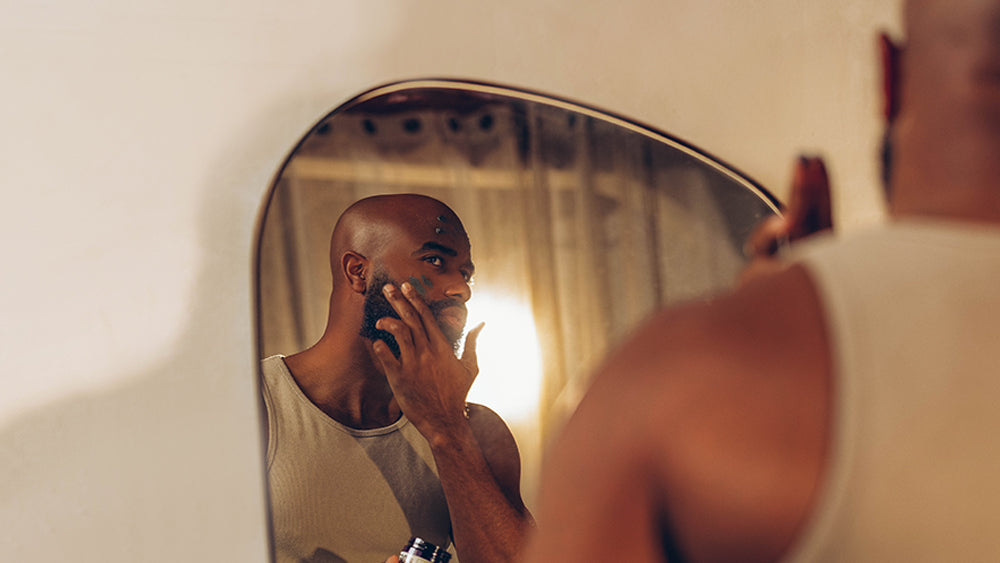
Bumps Under Beard: Prevention & Treatment
|
|
Time to read 4 min
|
|
Time to read 4 min
Beard bumps are a common problem for men with facial hair, often manifesting as bumps under the beard. Also known as pseudofolliculitis barbae, these bumps are caused by ingrown hairs that curl back into the skin, causing inflammation and irritation. Razor bumps and folliculitis, a bacterial infection of the hair follicles, can also contribute to bumps in the beard.
If you're tired of dealing with these pesky bumps under your beard, don't worry – there are plenty of ways to prevent and treat them. In this article, we'll discuss natural ingredients and grooming techniques to help soothe skin irritation, reduce beard bumps, and prevent ingrown hairs.
Beard bumps, including bumps in the beard, are typically caused by hair that curls back and grows into the skin, resulting in inflammation and irritation. This can occur when hair is cut too short, pulled too tightly during shaving, or grows back at an angle. Other factors that can contribute to bumps on the beard include:
Preventing beard bumps requires proper grooming techniques and good skin care practices. Here are some tips to help prevent beard bumps:
If you already have beard bumps or bumps in your beard, several treatment options are available to help alleviate the symptoms and promote healing. Here are some options to consider:
Pseudofolliculitis barbae, can be frustrating for men with facial hair. This article explains how to treat and prevent beard bumps, ingrown hairs, and razor bumps using natural ingredients and proper grooming techniques.
Beard bumps are typically caused by ingrown hairs, when the hair curls back into the skin instead of growing straight out. This same ingrown hair can happen when it is cut too short or grows in at an angle. If left untreated, ingrown hairs can cause redness, inflammation, and even infection.
Razor bumps, also known as razor burn, can contribute to beard bumps. Razor bumps occur when the hair follicles and sensitive skin become irritated after shaving, leading to redness, itching, and inflammation. In severe cases, razor bumps can cause scarring.
Folliculitis, a bacterial infection of the hair follicles, can also cause beard bumps. This condition can be caused by various factors, including bacteria, yeast, and even certain medications. Symptoms of folliculitis include small red bumps, itching, and skin inflammation.
Several natural ingredients can help soothe skin irritation and reduce the appearance of beard bumps. Here are some of the most effective:
Aloe vera is a natural anti-inflammatory that can help soothe irritated skin. To use aloe vera for beard bumps, apply a small amount of the gel to the affected area and let it sit for 10-15 minutes before rinsing off.
Witch hazel is a natural astringent that can help reduce inflammation and redness. To use witch hazel for beard bumps, apply a small amount to a cotton ball and gently dab it onto the affected area.
Tea tree oil is a natural antibacterial and anti-inflammatory that can help prevent infection and soothe irritated skin. To use tea tree oil for beard bumps, dilute a few drops in a carrier oil (such as jojoba oil) and apply it to the affected area.
Jojoba oil is a natural moisturizer that can help hydrate and soothe dry, irritated skin. To use jojoba oil for beard bumps, simply apply a small amount to the affected area and massage in gently.
Gentle exfoliation can help remove dead skin cells and prevent ingrown hairs. To exfoliate the beard area, use a gentle scrub or a washcloth to buff the skin in circular motions gently.
Using a non-comedogenic moisturizer can help hydrate the skin without clogging pores or causing further irritation. Look for moisturizers that contain natural ingredients, such as aloe vera or jojoba oil.
Shop MY Beginners Skin Care Kit
Beard bumps and razor bumps are both types of ingrown hairs, but beard bumps specifically refer to ingrown hairs that occur on the beard and neck area.
No, beard bumps are not contagious. They are caused by hair that grows back into the skin, not by a virus or bacteria.
The length of time it takes for beard bumps to go away can vary depending on the severity of the condition and the treatment options used. Sometimes, it may take several weeks or even months for the bumps to fully heal.
Yes, shaving too often or too closely can increase the risk of beard bumps by irritating the skin and causing hair to grow back into the skin.




